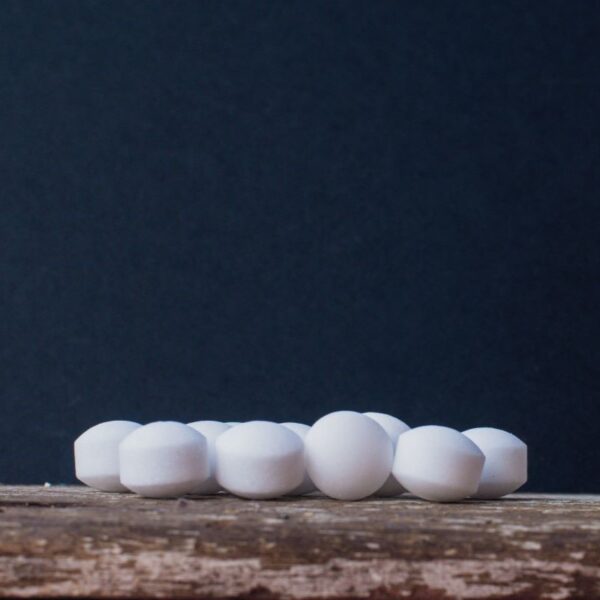Aluminum oxide, also known as alumina, is one of the world’s most abundant and widely used oxides. Aluminum oxide exists in various forms, including crystalline solids and amorphous powders. It may appear as a white or off-white solid with a high degree of hardness.
What is Aluminum Oxide?
Aluminum oxide (chemical formula Al2O3) is a compound of aluminum and oxygen atoms. The most common crystalline forms of aluminum oxide are alpha-Al2O3 and gamma-Al2O3. Alpha-Al2O3 has a hexagonal close-packed structure, while gamma-Al2O3 has a cubic structure. The arrangement of atoms in the crystal lattice contributes to its physical and chemical properties.
Source: ChemSpider
How is Aluminum Oxide Produced?
Aluminum oxide occurs naturally and is one of the most abundant minerals on Earth, appearing in various forms collectively known as aluminum oxide minerals or alumina minerals. The most common natural forms of aluminum oxide include:
- Corundum: Corundum is the most well-known and abundant form of aluminum oxide. It is a crystalline form of aluminum oxide with a hardness second only to diamond. Gem-quality corundum comes in two primary varieties: ruby red and sapphire, which can be blue, pink, yellow, green, or other colors.
- Bauxite: Bauxite is a mixture of aluminum oxide minerals, primarily gibbsite, boehmite, and diaspore, along with other impurities like iron oxides, silica, and clays. Bauxite is the primary source of aluminum ore and is the main raw material used to extract aluminum metal.
Aluminum oxide is extracted from bauxite ore via the Bayer process, a well-established and widely used industrial method. Bauxite ore is mined from deposits, primarily in tropical or subtropical regions. The ore is then crushed and processed to remove impurities like silica, clay, and other minerals.
The purified bauxite is mixed with hot, concentrated sodium hydroxide (NaOH) solution in high-pressure autoclaves. This mixture dissolves the aluminum oxide content of the ore, forming soluble sodium aluminate. The impurities, however, do not dissolve and remain behind as a residue. The hot solution from the digestion step is then cooled and allowed to settle. This settling process causes the impurities to settle out and form red mud at the bottom of the vessel.
The clear liquid, containing the dissolved sodium aluminate, is separated from the settled impurities using filtration. Carbon dioxide gas is bubbled through the filtered sodium aluminate solution. This causes the aluminum hydroxide to precipitate out of the solution.
The chemical reaction involves the neutralization of sodium aluminate to form aluminum hydroxide and sodium carbonate.
Na2Al(OH)4 + CO2 → Al(OH)3 + Na2CO3
The aluminum hydroxide precipitate is then heated to high temperatures in rotary kilns or fluidized bed calciners. This process drives off the water and converts aluminum hydroxide into aluminum oxide (alumina).
2 Al(OH)3 → Al2O3 + 3 H2O
The resulting aluminum oxide can be further processed and used for various industrial applications.
Use of Aluminum Oxide in Industrial Applications
Aluminum oxide has a wide range of uses and applications due to its unique properties. Here are some of its most common uses:
Abrasives: Aluminum oxide is often used as an abrasive material in sandpaper, grinding wheels, and polishing compounds. Its hardness and durability make it practical for material removal and surface finishing.
Ceramics & Refractories: Aluminium oxide is a key component in producing ceramics and refractories. Its high melting point, electrical insulating properties, and resistance to chemical corrosion make it suitable for use in ceramic tiles, spark plugs, and kiln linings. Aluminum oxide is also a key material in advanced ceramic applications, such as cutting tools, ball bearings, and components for semiconductor manufacturing, due to its exceptional hardness, wear resistance, and thermal properties.
Catalysts: Gamma alumina (gamma-Al2O3) is widely used as catalyst support in various chemical processes. The unique structure of gamma alumina allows for a high density of surface active sites, which are crucial for catalytic reactions. Its porosity also provides spaces where reactants can adsorb and interact with the catalyst, enhancing the reaction rates.
Electrical Insulators: Aluminum oxide ceramics are widely used as insulating materials in electrical systems. Aluminum oxide’s high electrical resistivity and insulating properties prevent the flow of electric current between conductive components, ensuring proper isolation and safety. Aluminum oxide is used as a substrate material for circuit boards, especially in high-power and high-temperature applications. These circuit boards provide electrical insulation and mechanical support for electronic components.
Fillers and Extenders: Alumina can be used as a filler or extender in various products, including paints, coatings, plastics, and rubber, to improve their mechanical properties and increase durability.
- Paints and Coatings: Alumina can be added to paints and coatings to improve their viscosity, increase resistance to wear and abrasion, and enhance the overall durability of the finished surface. It also helps prevent the settling of pigments, providing a more consistent appearance.
- Plastics: Alumina is often incorporated into plastics to enhance their thermal conductivity, electrical insulation properties, and mechanical strength. It can also reduce shrinkage during plastic products’ curing or cooling process.
- Rubber: In rubber compounds, alumina can act as a reinforcing filler, improving the strength, flexibility, and wear resistance of rubber products such as tires, hoses, and gaskets.
- Adhesives and Sealants: Alumina can be included in adhesive and sealant formulations to enhance their bonding strength, improve resistance to environmental factors, and increase their overall durability.
- Construction Materials: Alumina can be added to construction materials like concrete and mortar to enhance their strength and durability. It can also improve the resistance of these materials to harsh weather conditions and chemical exposure.
Dental and Medical Applications: Alumina ceramics are used in dental implants and prosthetics. Alumina can also be used in medical devices like orthopedic implants.
- Dental Implants: Alumina ceramics are used as dental implant materials due to their biocompatibility with human tissues and their ability to integrate with the surrounding bone. Dental implants made from alumina offer long-term stability, durability, and a natural appearance, making them a preferred choice for replacing missing teeth.
- Dental Prosthetics: Alumina-based ceramics create dental crowns, bridges, and other prosthetic restorations. These ceramics can closely mimic the appearance and translucency of natural teeth, providing aesthetically pleasing results.
- Orthopedic Implants: Alumina ceramics, such as hip and knee joint replacements, are used in orthopedic implants. The high mechanical strength and biocompatibility of alumina make it a suitable material for implants that need to withstand the stresses and demands of weight-bearing joints.
Flame Retardants: Aluminum oxide is often used as a flame retardant in various materials. Its ability to absorb heat and release it slowly helps reduce flammability. When incorporated into polymers, textiles, and other products, alumina can act as a barrier that delays or inhibits the spread of flames. This property is crucial for improving fire safety in various industries, including construction, automotive, and electronics.
Glass Production: Alumina is a common additive in glass manufacturing. When added to glass formulations, alumina can enhance the glass’s mechanical strength, thermal shock resistance, and overall durability. It also contributes to preventing cracking or breaking under rapid temperature changes. Alumina-modified glass is ideal in applications where resilience and resistance to extreme conditions are necessary, such as in cookware, laboratory glassware, and specialized glass products like high-intensity discharge lamps.
Properties of Aluminum Oxide
| Chemical formula | Al2O3 |
| Molecular weight (g/mol) | 101.96 |
| Odor | Odorless |
| Appearance | White solid |
| Melting point(°C) | 2072 |
| Boiling Point (°C) | 2977 |
| Density (g/cm³) | 3.987 |
| Solubility | Aluminum oxide is insoluble in water and solvents. But Aluminum oxide (Al2O3) is amphoteric, meaning it can react with both acids and bases. |
Aluminum Oxide Derivatives
- Activated Alumina: Activated alumina is a porous material derived from aluminum oxide. It has a high surface area and is commonly used as a desiccant to remove moisture from gasses and liquids. It can also be used for the adsorption of impurities from liquids, such as in water treatment processes.
- Aluminum Hydroxide (Alum Hydrate): This is a compound derived from aluminum oxide and is commonly used as a flame retardant and smoke suppressant in various materials, including plastics, rubber, and textiles. It releases water vapor when heated, which can help cool the material and reduce the spread of flames.
- Aluminum Oxide Nanoparticles: Nanoparticles of aluminum oxide have unique properties due to their small size. They are used in various applications, including catalysis, electronics, coatings, and as reinforcement in polymers, ceramics, and composites.
- Yttrium Aluminum Garnet (YAG): YAG is a synthetic crystal derived from aluminum oxide and yttrium oxide. It is used as a laser material in various applications, including medical, industrial, and scientific research.
Safety & Toxicity of Aluminum Oxide
The acute health effects of aluminum oxide include skin and eye and respiratory irritation.
- Skin and Eye Irritation: Direct contact with aluminum oxide can irritate the skin and eyes. This can lead to redness, itching, or discomfort.
- Respiratory Irritation: Inhaling aluminum oxide particles can irritate the respiratory system, including the nose, throat, and lungs. This irritation could result in symptoms like coughing, wheezing, and shortness of breath.
Chronic health effects are unclear and require additional study.
- Cancer Hazard: Although aluminum oxide has been tested, its potential to cause cancer is not definitively classified. This suggests that there’s no clear evidence, but more research is needed to make a conclusive determination.
- Reproductive Hazard: The available information does not provide conclusive evidence about aluminum oxide’s effects on reproduction. This implies that its impact on reproductive health hasn’t been thoroughly studied.
Exposure Limits
| OSHA | According to OSHA, the legal airborne permissible exposure limit (PEL) is 5 mg/m3 (as respirable dust) and 15 mg/m3 (as total dust) averaged over an 8•hour work shift. |
| ACGIH | According to ACGIH, the threshold limit value (TLV) is 1 mg/m3 (as the respirable fraction for aluminum) averaged over an 8-hour work shift. |
Identification Numbers
| CAS Number | 1344-28-1 |
| RTK Substance Number | 2891 |
| EC Number | 215-691-6 |
Fun Facts About Aluminum Oxide
- While the pure form of aluminum oxide is white, it can take on various colors when impurities are present. For instance, trace amounts of chromium can lead to the red color of rubies, and iron and titanium impurities can result in blue sapphires.
- Aluminum oxide-based materials, specifically ceramic materials, have been used in spacecraft heat shields to protect against the intense heat generated during reentry into Earth’s atmosphere. The heat generated during reentry can reach several thousand degrees Celsius due to the friction between the spacecraft and the atmospheric gasses.





